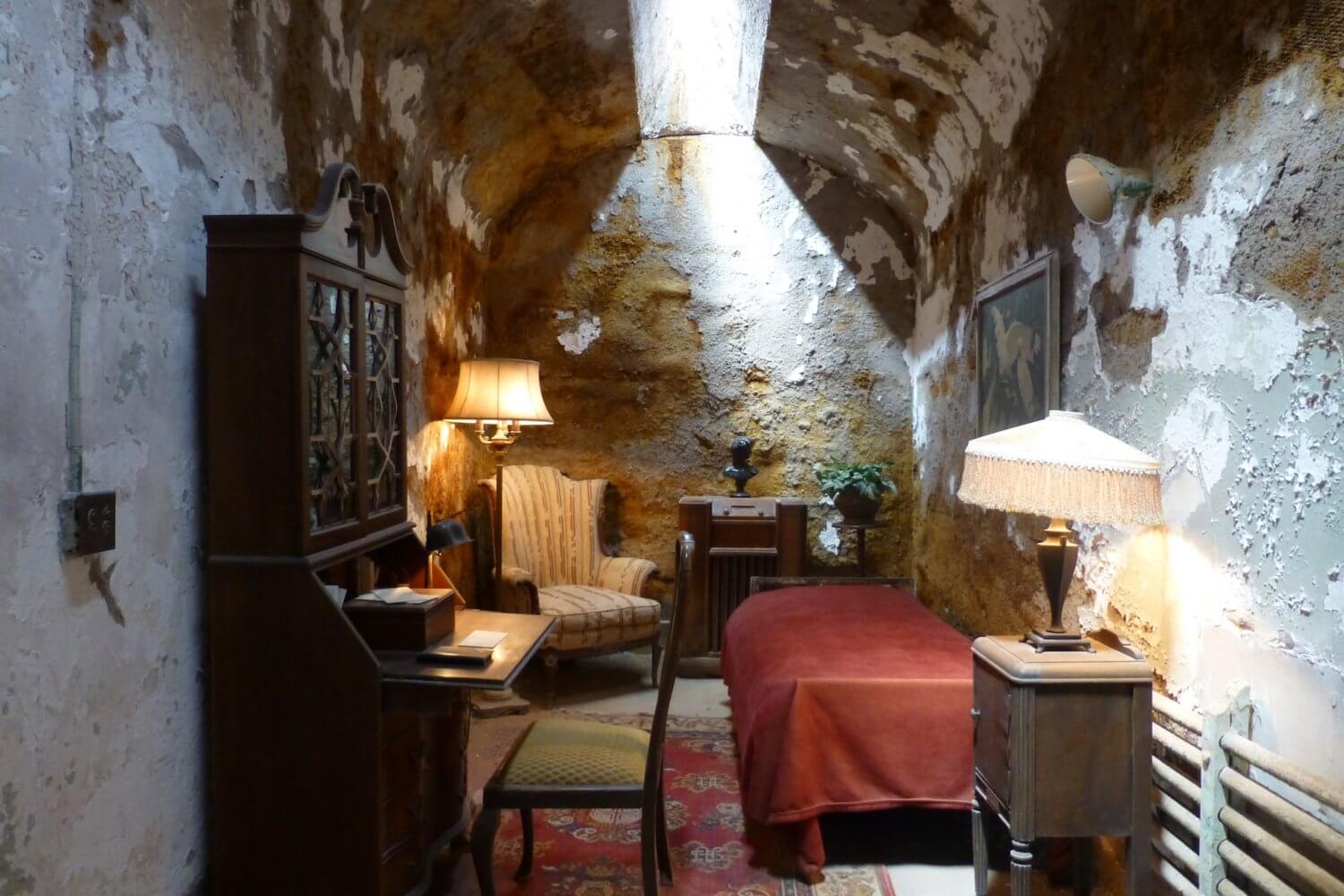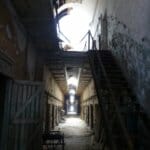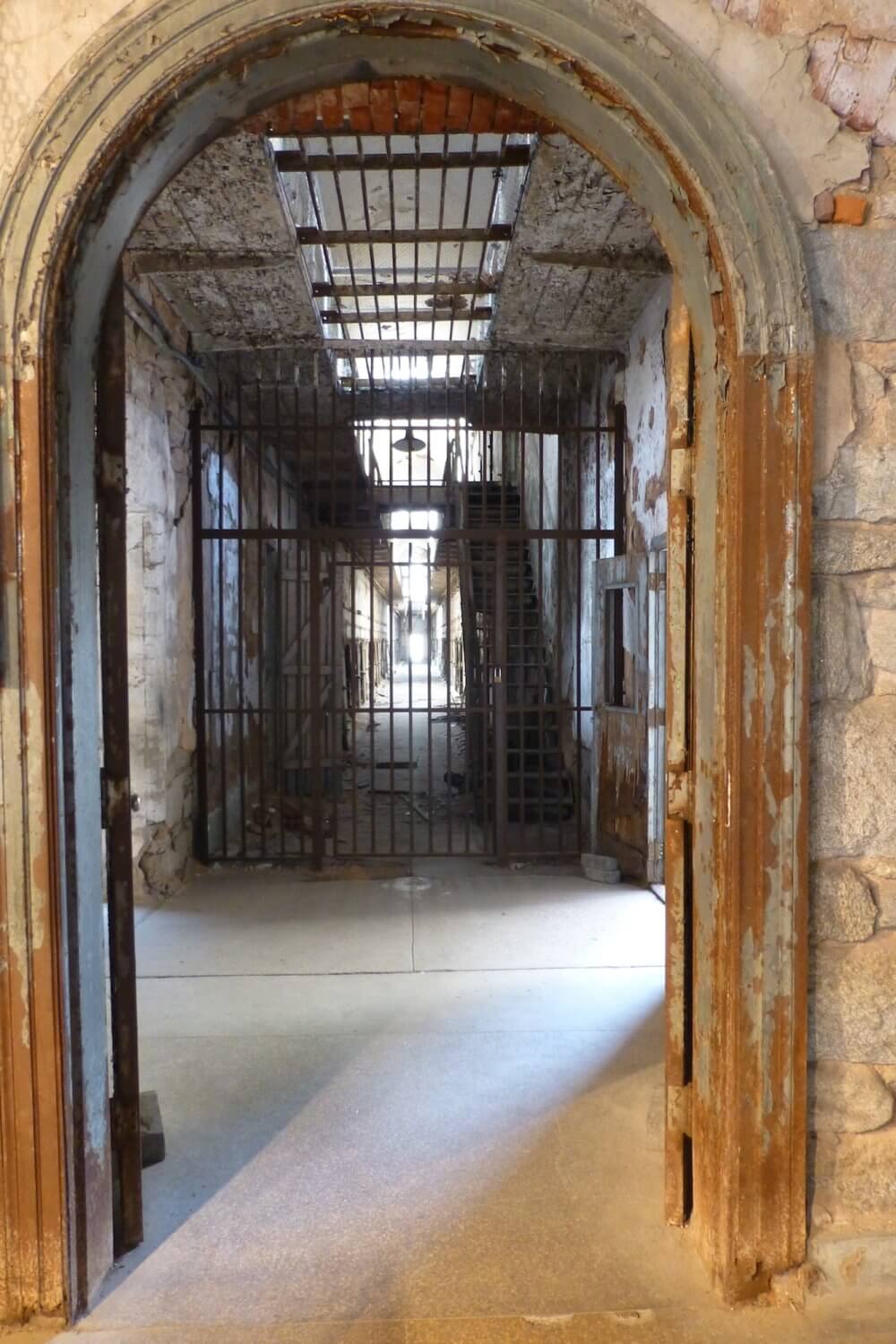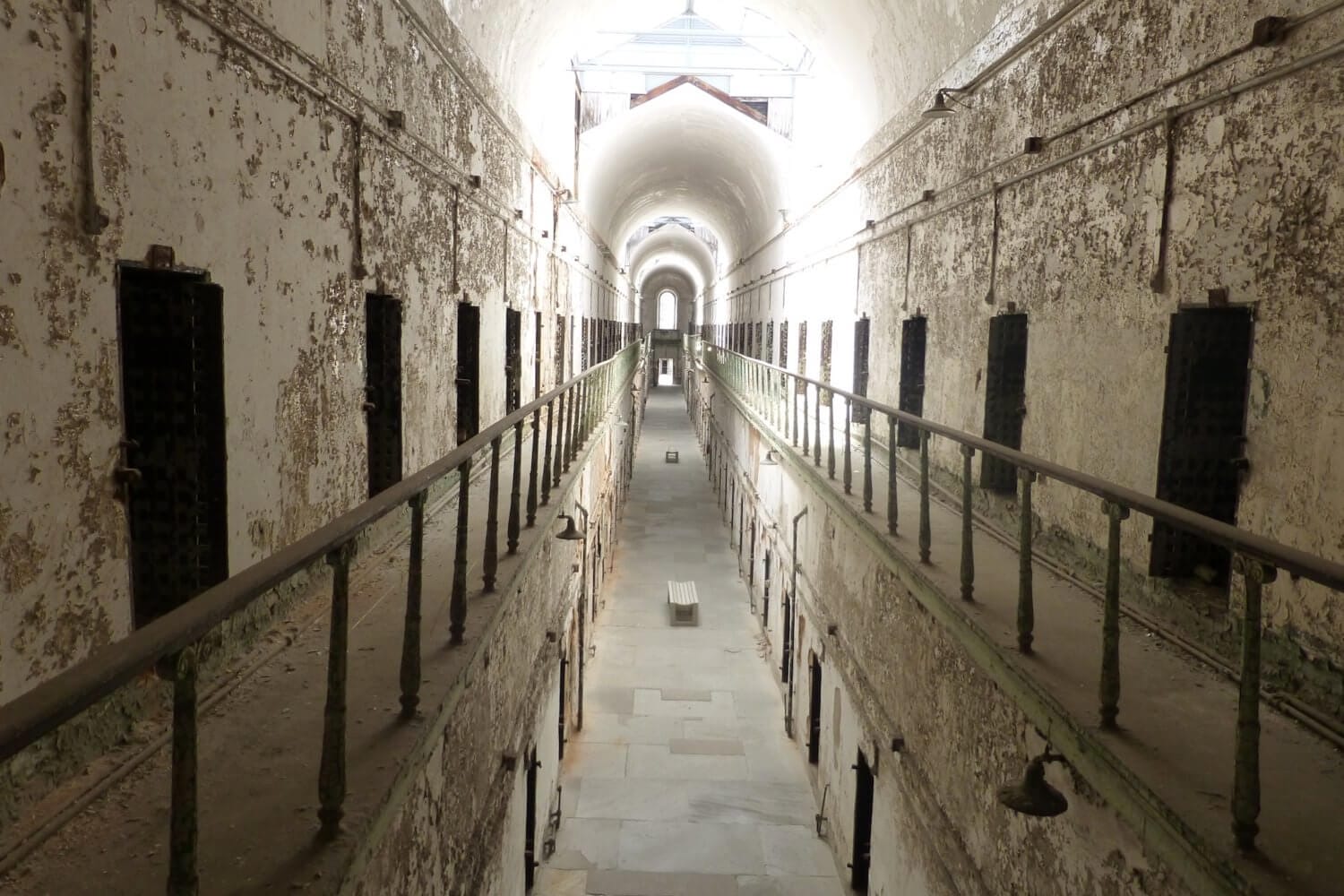Sitting ominously atop a hill in the residential district of Fairmount in Philadelphia, the Neo Gothic walls of Eastern State Penitentiary are as imposing today as they were when the building first opened in 1829 becoming home to 450 prisoners.
A pioneer of the “Pennsylvania System” of incarceration in the 19th century, inmates were kept in solitary confinement even having their own individual exercise yards. Their only human contact was from the warden who was legally required to visit each inmate once per day, and guards who had to see each inmate 3 times a day as part of their rehabilitation.

Prior to the construction of cell block 7, the previous two-level blocks (4, 5 and 6) overhung the ground level blocking guards views.
The choice of the Pennsylvania System was a curious decision at the time because the United States
favoured the Auburn System (also known as the “New York System”) where prisoners would be subjected to physical punishment and be forced to work together in silence. The radial floor plan of Eastern State was revolutionary for its time and, along with the Pennsylvania System, would eventually be copied in over 300 prisons worldwide.
Throughout its life, Eastern State Penitentiary was home to scandal, breakout attempts, and the odd celebrity prisoner. Perhaps the most famous of these celebrities is Al Capone who occupied a cell for 9 months starting in May 1929. Living in relative luxury compared to fellow inmates, his cell was adorned with rugs, electricity and heating. Running water was built into the prison, so forward thinking was its architect, John Hallivand, that the prison opened with primitive central heating and flushing toilets while even the President of the United States was relying on coal fires to warm the White House.

For Al Capone’s short 1 year tenure at Eastern State, he was allowed to furnish his cell with luxuries few inmates could dream of. You can find it near the rotunda just inside cell block 8.
The prison closed in 1971 after a short spell housing inmates from Holmesburg Prison after a riot. The building was purchased by the city with a view to redeveloping the land and received several proposals including a shopping mall and luxury apartments. Ultimately planning delays and cost scuppered any redevelopment plans and the building was left to rot until 1991. In 1988 Eastern State Penitentiary Taskforce successfully petition the then mayor to halt any redevelopment. Eastern State Penitentiary opened its doors to the public for historic tours in 1994.

Once the prison moved away from the Pennsylvania System of incarceration a separate kitchen block was constructed. This is the remains of one of the 2 mess halls where prisoners would gather to eat.
Today the building stands still partly in ruin. The cost of restoration and upkeep is so substantial, in 1996 and again in 2000, the the World Monuments Fund placed Eastern State Penitentiary on its World Monuments Watch, a biennial list of the world most

The ruins of cell block 6 which, due to the scale of restoration needed, still can’t be opened to the public.
endangered cultural heritage sites.
This historic landmark as synonymous with Philadelphia as the world famous Rocky Steps on the eastern side of the Philadelphia Museum Of Art, today attracts hundreds of thousands of annual visitors to its 11 acre site.
The stories so vividly brought to life throughout the 3 hour self guided audio walking tour are supplemented with real life accounts from many of the volunteers that used to be inmates at the jail.
No matter what time of year you visit you will be surprised with the multiple ways the prison tries to educate you in not only the history of this building but also of the criminal justice system in America. Throughout the year numerous art exhibitions are held in all kinds of spaces dotted around the complex. Exploring off the beaten path here is rewarded with unique insights into the penal system and a glimpse of what the restorers have had to overcome to get to the point we see today.

A lot of Eastern State remains behind bars for health and safety reasons but a refreshing amount of the prison is open for guests to wander.
Much of the building still lays in ruins; crumbling walls, caved in ceilings, rubbish filled cells. Entire cell blocks are still behind bars and padlocked gates, waiting for such time that they can be reclaimed from nature that engulfed the site in its years of abandonment. In the first 15 years after the gate was closed the final time, a forest swamped all areas within the walls. Roots crumbled cement that had held men bringing entire cell blocks caving in on themselves. The baseball field between cell blocks 3 and 4 could have doubled as a set for Tarzan, so dense was the undergrowth. The building had given itself up, it had become one again with nature and that is the one of the main causes of restoration problems.
Its sad that a building so elegantly thought out has been reduced to this but at the same time it is also refreshing that a tourist “attraction” nowadays is not afraid of its past. It wears it like a badge of honor. Like the closed cells and entire blocks, the history of Eastern State Penitentiary is sometimes dark. It shouldn’t be hidden away or glossed over, the stories that you will hear are the soul of the building.

As the inmate count grew Eastern State had to adapt. Here you can see that behind a crumbling wall are the sealed doors that would once have lead out onto a solitary exercise yard. Every cell had one at the start.
The fact that it’s not hidden, it’s is embraced, is a testament to the unique nature of your time here. You will learn what was wrong and what still is wrong with the US penal system and that is like a breath of fresh air for a former prison.
Eastern State Penitentiary can be a dark and foreboding place but the stories contained within its walls; stories of survival, death and overcoming insurmountable odds will both surprise and shock you in equal measure. Instead of another historic landmark being levelled to create luxury condos, the shell of Eastern State Penitentiary survives today but without the stories of the volunteer former inmates they would just be walls.
Bringing those walls to life are the volunteers and for that they should be celebrated. If you’re ever in Philadelphia make sure to pop in and spend a morning or afternoon contemplating what life was like while sitting in one of the few solitary confinement cells. You will emerge with a new look on life.

The cathedral like cell block 7, finished in 1836, marked the end of construction of the original Eastern State Penitentiary.
 Copyright secured by Digiprove © 2017
Copyright secured by Digiprove © 2017




